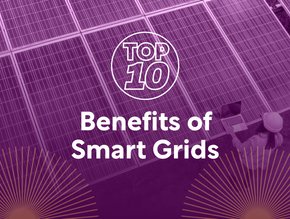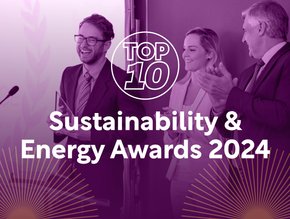Top 10: Most Popular Renewable Energy Sources

Renewable energy can be classified as originating from a natural source that replenishes itself. Scientists have stated that to avoid the worst impacts of climate change, emissions need to be reduced by almost half in the next ten years. It is no surprise that renewable energy has been described as a ‘solution’ to avoid the worst impacts of climate change, as well as ensuring that humanity relies less on fossil fuels.
The UN has suggested that 30 million jobs can be created as a result of renewable energy sources. Energy Magazine is therefore considering 10 of the most popular current sources for renewable energy.
10: Biomass
Biomass is generated from burning wood, plants and other organic matter, such as manure or household waste. According to the Energy Saving Trust, it has the potential to use considerably less carbon dioxide (net carbon emissions) than fossil fuels, and can be considered renewable if the plants are being replaced.
In addition, biomass is less expensive than fossil fuels and can be used for fuels, power, and products that would otherwise be made from fossil fuels. Technologies can be created from biomass, including biofuels, conversion into heat and electricity and chemicals for making plastics.
9: Ethanol fuel
Ethanol fuel is most often used as a motor fuel as an alternative to petrol or gasoline. It is the same as the ethyl alcohol that you find in alcoholic drinks and often obtained from corn or grains. It has been determined to reduce emissions and so it can be blended with gasoline to increase the octane level of the fuel.
With plenty of governments now prioritising the reduction of fuel emissions (London’s ULEZ zone expansion this year for example), the use of ethanol fuels has greatly increased over the past decade.

8: Hydropower
Also sustainable, is Hydropower (also known as water power), which is the use of falling or fast-running water to make electricity or to generate power. This is conducted by converting the kinetic energy of the water to produce the power, which is often by building a dam to control the flow of a river or large body of water.
The benefits of this power is that it is a clean source of energy and it does not rely on international fuel sources. It also allows for greater flood control and clean drinking water, whilst being a very affordable, low-cost type of energy.
7: Hydroelectric
Much like hydropower, this type of renewable power uses moving water to generate electricity. It is the most widely used renewable energy source worldwide. Most have a reservoir of water, which gains potential energy before it spills over the top of a dam or flows down a hill. This is then used to generate electricity for customers.
These plants produce no direct waste and typically emit much less greenhouse gas than fossil fuel-powered energy plants. However, with some structures, there has been disruption caused to the environment around them.
6: Geothermal
Geothermal energy is heat from within the earth and is continually produced. Electricity generated from the ground is currently used in 26 countries, with geothermal heating being used in 70 countries. The main advantage of this is that it is always readily available, so there is less demand to actually generate power.
One of the countries that is perhaps most well-known for utilising geothermal power is Iceland, with 30% using geothermal power because of the very active geology within the country. Geothermal energy now heats more than 90% of the houses in Iceland, with the country operating with 100% renewable energy.
5: Marine/Ocean
In generating power in the ocean, the term marine power includes wave power (surface waves) and tidal power (kinetic energy of large bodies of water). This type of power is harnessed from the natural power of the ocean and the technologies involved can include turbines and paddles.
According to Dr. Abdus Samad and R. Suchithra, energy can be extracted from the sea in several ways. These methods include salinity (salt concentration), temperate, waves and ocean currents. Ultimately, this method of harnessing energy has huge potential as a source of renewable energy.
4: Tidal
More specific to water levels, tidal power or tidal energy is obtained by converting energy from tides into useful forms of power, mainly electricity. Although not yet widely used, tidal energy has the potential for future electricity generation. Tidal energy could be used instead of burning coal and oil that contribute to global warming, as well as transporting and capturing energy by ocean waves.
National Geographic has suggested that tides can be more predictable than alternative forms of renewable energy, like wind and solar power. This is because water is more dense and therefore more powerful, ultimately creating a more reliable energy source.
3: Photovoltaic solar energy
Photovoltaic solar energy is obtained by converting sunlight into electricity using a technology based on the photoelectric effect. The system converts radiation from the sun (sunlight) into usable electricity. Most commonly recognised in solar panels, the panel consists of cells made from layers of semiconducting material. When light shines on it, a flow of electricity is created as a result.
Whilst more electricity is generated on sunny days, the cells do not need direct sunlight to work. It can often be used as standalone power, as they can provide electricity to parking metres, radio transmitters and emergency phones, for example.
2: Solar thermal power
Slightly similar, solar thermal power systems use concentrated solar energy to generate thermal energy for use. This is done by heat-transfer circulating to produce steam, which is then converted into mechanical energy to produce electricity. Currently, it is used in industry and commercial sectors, as well as residential areas.
The main source of heat generation is through roof mounted solar panels which are used in conjunction with a heat source, such as a boiler, collector or immersion heater. The solar source will collect sunlight, before being pumped to the heat source and being heated inside. It is a common misconception that this type of power cannot be used in the UK, as any type of light from the sun is suitable.

1: Wind - onshore and offshore
Wind power is used both onshore and offshore around the world and is well-known for its small impact on the environment. Harnessed by wind turbines, these can be placed in groups in either the ground or offshore in the ocean. In 2021, wind generated 6.6% of global electricity, which was up from 3.5% in 2015 when the Paris Agreement was signed. There are still calls for this amount to increase, however.
Some disadvantages of wind power are that often, suitable sites for wind power are often in remote locations, as well as affecting the landscape on account of being very visible and producing noise. However, it is considered to be a very sustainable type of power, with the turbines themselves not producing any emissions.






